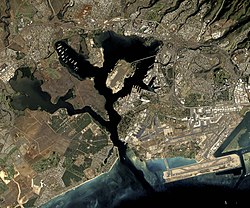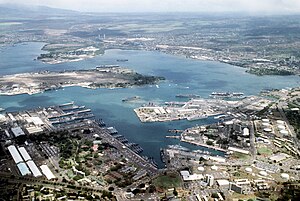Pearl Harbor

Pearl Harbor is a simple harbor on the island of Oʻahu, Hawaiʻi, west of Honolulu. Much of the harbor and surrounding lands is a United States Navy deep water naval base: headquarters of the U.S. Pacific Fleet. The attack on Pearl Harbor by Japan on December 7, 1941 brought the United States (the sleeping giant) into World War II.
History
1800-1941
Pearl Harbor was originally an extensive, shallow embayment called Wai Momi (meaning "water of pearl") or Pu'uloa by the Hawaiiians. Pu'uloa was regarded as the home of the shark goddess Ka'ahupahau and her brother, Kahi'uka. The harbor was teeming with pearl-producing oysters until the late 1800s.
In the years following the arrival of Captain James Cook, Pearl Harbor was not considered a suitable port due to shallow water. The United States of America and the Hawaiian Kingdom signed the Reciprocity Treaty of 1875 as supplemented by Convention on December 6, 1884 and ratified in 1887. On January 20, 1887, the United States Senate allowed the Navy to lease Pearl Harbor as a naval base (the US took possession on November 9 that year). The Spanish-American War of 1898 and the desire for the United States to have a permanent presence in the Pacific both contributed to the decision.
After annexation, Pearl Harbor was refitted to allow for more navy ships. In 1908 the Pearl Harbor Naval Shipyard was established. In 1917, Ford Island in the middle of Pearl Harbor was purchased for joint Army and Navy use in the development of military aviation in the Pacific.
As the Japanese military pressed its war in China, security concerns caused the U.S. to begin taking defensive measures. On February 1, 1933, the U.S. Navy staged a mock attack on the base at Pearl Harbor as part of a preparedness exercise. The attack "succeeded" and the defense was deemed a "failure".
The actual suprise attack on Pearl Harbor by the Empire of Japan on December 7, 1941 brought the United States into World War II.

December 7, 1941
- Related article: Attack on Pearl Harbor
On the morning of December 7, 1941, planes and midget submarines of the Imperial Japanese Navy began a surprise attack on the U.S. under the command of Vice Admiral Chuichi Nagumo. It has to be remarked that the attack might have been no surprise as vital intelligence information about the imminent attack was not passed to the Navy commander Admiral Husband E. Kimmel and Army commander Walter Short. "General Short said as I was taking my leave from his quarters to board the flight to San Francisco, 'You could well save the day, perhaps you could well be the last hope. If I had my say, my command would be on Red Alert now.' " [1] This attack brought the United States into World War II. At 6:09 a.m. on December 7, the six Japanese carriers launched a first wave of 183 planes composed of torpedo bombers, dive-bombers, level bombers and fighters, the most well remembered Japanese plane being the Mitsubishi Zero. The Japanese hit American ships and military installations at 7:55 a.m. They attacked military airfields and at the same time they hit the fleet anchored in Pearl Harbor. The Battleship Arizona was hit with an armor piercing bomb which penetrated the forward ammunition compartment, blowing the ship apart. Overall, twenty-one ships of the U.S. Pacific fleet were damaged and the death toll reached 2,403, along with 68 civilians and 1,178 injured. Of the military personnel lost at Pearl Harbor, 1,177 were from the Arizona.
West Loch Explosion, 1944
On May 21, 1944, LST-353 exploded at West Loch while handling ammunition. In a short space of time six LSTs were so damaged that they sank. Two others were severely damaged. 163 sailors were killed; 396 wounded.[1] This was the second worst incident in the United States during World War II.
Films and books
Fiction
- The Final Countdown is a movie set around Pearl Harbor, in which the nuclear aircraft carrier, USS Nimitz, from 1980 is time-warped back to December 6, 1941, one day before the attack on the base.
- From Here to Eternity by James Jones. The attack on Pearl Harbor plays a crucial role for Robert E. Lee Prewitt.
- In an episode of Freakazoid!, the hero goes back to 1941 and prevents the attack from happening.
- The first season of seaQuest DSV featured Pearl Harbor as the headquarters of the United Earth Oceans Organization (U.E.O.). In the episode "Games", a murderous criminal seizes control of the seaQuest's weapons system and directs four missiles from the ship towards Pearl Harbor. Fortunately, Captain Nathan Bridger had anticipated that the criminal would attempt to gain control of the weapons and ordered all the warheads to be disarmed. Later, in the episode "The Sincerest Form of Flattery", an experimental submarine piloted by a computerized profile of Captain Bridger launched a missile attack at Pearl Harbor, believing it to be part of a war games exercise.
- Under the Blood-Red Sun is a novel by Graham Salisbury. This story takes place on the State of Hawaii before, during and after the attack on Pearl Harbor.
'Historical' fiction
- Tora! Tora! Tora! is a movie about the Japanese attack on Pearl Harbor. Many consider this to be the most faithful movie re-telling of the attack as it deals with many aspects of the battle with attention to historical fact. title=USS Arizona and Pearl Harbor
- Pearl Harbor is the title of a 2001 film about the 1941 attack. The film is a love story rather than an accurate portrayal of the event, although some of the events portrayed actually took place. Some of the ships in the harbor, if you pay close attention, are completely out of order and misplaced. A number of the shipboard scenes were actually filmed on the USS Lexington in Corpus Christi, TX.
The film is directed by Michael Bay and starring Ben Affleck, Josh Hartnett and Kate Beckinsale.
Non-Fiction/Historical
- At Dawn We Slept: The Untold Story of Pearl Harbor by Gordon W. Prange is an extremely comprehensive account of the events leading up to the Pearl Harbor attack. It is a balanced account that gives both the perspective of the Japanese and United States. Prange spent 37 years researching the subjects by studying documents about Pearl Harbor and interviewing surviving participants to attempt the most exhaustive truth about what happened to bring the Japanese to attack the United States at Pearl Harbor, why the United States intelligence failed to predict the attack, and why a peace agreement was not attained. The Village Voice said about At Dawn We Slept, "By far the most exhaustive and complete account we are likely to have of exactly what happened and how and why."
- The Attack on Pearl Harbor: An Illustrated History by Larry Kimmett and Margaret Regis is a careful recreation of the "Day of Infamy" using maps, photos, unique illustrations, and an animated CD. From the early stages of Japanese planning, through the attack on Battleship Row, to the salvage of the U.S. Pacific fleet, this book provides a detailed overview of the attack.
Alternate History
- Days of Infamy is a novel by Harry Turtledove in which the Japanese attack on Hawaiʻi is not limited to a strike on Pearl Harbor, but is instead a full-scale invasion and eventual occupation after U.S. forces are driven off the islands (something that one of the key planners of the attack, Commander Minoru Genda wanted but the higher-ups rejected). The many viewpoint characters (a Turtledove trademark) are drawn from Hawaiian civilians (both white and Japanese) as well as soldiers and sailors from both Japan and the USA. Turtledove has to date written one sequel, The End of the Beginning.
Ships currently homeported at Pearl Harbor
Surface ships presently homeported at Pearl Harbor
- USS Lake Erie (CG-70)
- USS Chosin (CG-65)
- USS Chung-Hoon (DDG-93)
- USS Paul Hamilton (DDG-60)
- USS Chafee (DDG-90)
- USS Hopper (DDG-70)
- USS Russell (DDG-59)
- USS Crommelin (FFG-37)
- USS Reuben James (FFG-57)
- USS Salvor (ARS-52)
Submarines presently homeported at Pearl Harbor
- USS Los Angeles (SSN-688)
- USS La Jolla (SSN-701)
- USS Buffalo (SSN-715) Moves to Guam in 2007.
- USS Charlotte (SSN-766) Undergoing extended maintenance at Norfolk Naval Shipyard, Va.
- USS Greeneville (SSN-772)
- USS Bremerton (SSN-698)
- USS Olympia (SSN-717)
- USS Honolulu (SSN-718) Will inactivate in 2007 at Puget Sound Naval Shipyard, Wash.
- USS Chicago (SSN-721)
- USS Key West (SSN-722)
- USS Louisville (SSN-724)
- USS Columbia (SSN-771)
- USS Pasadena (SSN-752)
- USS Columbus (SSN-762) Undergoing extended maintenance at Puget Sound Naval Shipyard, Wash.
- USS Santa Fe (SSN-763) Undergoing extended maintenance at Portsmouth Naval Shipyard, Maine.
- USS Tucson (SSN-770)
- USS Cheyenne (SSN-773)
As part of the 2006 Quadrennial Defense Review, the Navy announced in early 2006 that it would shift 60% of its attack submarines to the Pacific by 2010. As part of that shift, USS Jacksonville (SSN-699), currently homeported in Norfolk, Va., will move to Pearl Harbor in 2008. The state's namesake USS Hawaii (SSN-776) is also expected to be homeported in Pearl Harbor once it is commissioned.
References
- ^ "West Loch Disaster". Retrieved 2006-12-07.
External links
- Tour the Pearl Harbor Attack
- History of Pearl Harbor through World War II
- History of Pearl Harbor before December 7, 1941
- New Panoramas of Pearl Harbor after attack — Extreme Photo Constructions
- Pearl Harbor Naval Shipyard official site
- War comes to Hawaiʻi Honolulu Star-Bulletin, Monday, Sept. 13, 1999
- War comes to Hawaiʻi No Frames Version
- Pearl Harbor Day Commemorative Committee
